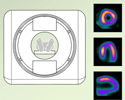Heart PET scan
Heart positron emission tomography; Myocardial PET scan
A heart positron emission tomography (PET) scan is an imaging test that uses a radioactive substance called a tracer to look for disease or poor blood flow in the heart.
Unlike magnetic resonance imaging (MRI) and computed tomography (CT), which reveal the structure of organs and blood flow to and from them, a PET scan gives more information about how organs and tissues are working.
A heart PET scan can detect whether areas of your heart muscle are receiving enough blood, if there is heart damage or scar tissue in the heart, or if there is a buildup of abnormal substances in the heart muscle.
How the Test is Performed
A PET scan requires a small amount of radioactive material (tracer).
- This tracer is given through a vein (IV), most often on the inside of your elbow.
- It travels through your blood and collects in organs and tissues, including your heart.
- The tracer helps the radiologist see certain areas or diseases more clearly.
You will need to wait nearby as the tracer is absorbed by your body. This takes about 1 hour in most cases.
Then, you will lie on a narrow table, which slides into a large tunnel-shaped scanner.
- Electrodes for an electrocardiogram (ECG) will be placed on your chest. The PET scanner detects signals from the tracer.
- A computer changes the results into 3-D pictures.
- The images are displayed on a monitor for the radiologist to read.
You must lie still during the PET scan so that the machine can produce clear images of your heart.
Sometimes, the test is done in conjunction with stress testing (exercise or pharmacologic stress).
The test takes about 90 minutes.
How to Prepare for the Test
You may be asked not to eat anything for 4 to 6 hours before the scan. You will be able to drink water. Sometimes you may be given a special diet before the test.
Tell your health care provider if:
- You are afraid of close spaces (have claustrophobia). You may be given a medicine to help you feel sleepy and less anxious.
- You are pregnant or think you might be pregnant.
- You have any allergies to injected dye (contrast).
- You take insulin for diabetes. You will need special preparation for the test.
Always tell your provider about the medicines you are taking, including those bought without a prescription. Sometimes, medicines may interfere with the test results.
How the Test will Feel
You may feel a sharp sting when the needle containing the tracer is placed into your vein.
A PET scan causes no pain. The table may be hard or cold, but you can request a blanket or pillow.
An intercom in the room allows you to speak to someone at any time.
There is no recovery time, unless you were given a medicine to relax.
Why the Test is Performed
A heart PET scan can reveal the size, shape, position, and some function of the heart.
It is most often used when other tests, such as electrocardiogram (ECG), echocardiogram and cardiac stress tests do not provide enough information.
This test can be used to diagnose heart problems and show areas in which there is poor blood flow to the heart.
Several PET scans may be taken over time to determine how well you are responding to treatment for heart disease.
Normal Results
If your test involved exercise, a normal test will usually mean that you were able to exercise for as long as or longer than most people of your age and sex. You also did not have symptoms or changes in blood pressure or your ECG that caused concern.
There are no problems detected in the size, shape, or function of the heart. There are no areas in which the radiotracer has abnormally collected.
What Abnormal Results Mean
Abnormal results may be due to:
Risks
The amount of radiation used in a PET scan is low. It is about the same amount of radiation as in most CT scans. Also, the radiation does not last for very long in your body.
Women who are pregnant or are breastfeeding should let their provider know before having this test. Infants and babies developing in the womb are more sensitive to the effects of radiation because their organs are still growing.
It is possible, although very unlikely, to have an allergic reaction to the radioactive substance. Some people have pain, redness, or swelling at the injection site.
Considerations
It is possible to have false results on a PET scan. Blood sugar or insulin levels may affect the test results in people with diabetes.
Most PET scans are now performed along with a CT scan. This combination scan is called a PET/CT.
References
Dorbala S, Di Carli MF. Nuclear cardiology. In: Libby P, Bonow RO, Mann DL, Tomaselli GF, Bhatt DL, Solomon SD, eds. Braunwald's Heart Disease: A Textbook of Cardiovascular Medicine. 12th ed. Philadelphia, PA: Elsevier 2022: chap 18.
Kramer CM, Beller GA, Hagspiel KD. Noninvasive cardiac imaging. In: Goldman L, Schafer AI, eds. Goldman-Cecil Medicine. 26th ed. Philadelphia, PA: Elsevier; 2020:chap 50.
Nensa F, Schlosser T. Cardiac positron emission tomography/magnetic resonance. In: Manning WJ, Pennell DJ, eds. Cardiovascular Magnetic Resonance. 3rd ed. Philadelphia, PA: Elsevier; 2019:chap 50.
Tamara LA. Cardiac positron emission tomography. In: Levine GN, ed. Cardiology Secrets. 6th ed. Philadelphia, PA: Elsevier; 2023:chap 9.
Review Date: 4/10/2023
Reviewed By: Michael A. Chen, MD, PhD, Associate Professor of Medicine, Division of Cardiology, Harborview Medical Center, University of Washington Medical School, Seattle, WA. Also reviewed by David C. Dugdale, MD, Medical Director, Brenda Conaway, Editorial Director, and the A.D.A.M. Editorial team.


